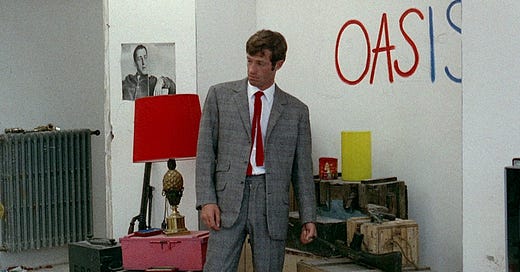Pierrot le fou: The End before The End for JLG
Godard himself, not quite prepared for his own metamorphosis.
Godard famously declared, at the end of his 1967 feature, Week End, that it was the end of cinema. If you’re interested at all in exploring how cinema reflected the social change of the 1960s, then Godard’s body of work in this decade is essential. Beginning with Breathless in 1960 and ending with Week End in 1967, Godard made fifteen features that illustrate the blast of excitement of the Nouvelle Vague, which descended into political anger and nihilism. Politics come into Godard’s pictures almost from the beginning, but it’s just about halfway through the decade that he dramatically shifts gears. Here, Pierrot le fou mixes his early exciting nouvelle vague style with what would come next.
1965 saw two releases from Godard: Masculin Feminin and Pierrot le fou. The former fits nicely in his black-and-white nouvelle vague (French New Wave) style, with numerous explorations of the relationships between men and women. The latter, however, takes the freewheeling nature of Godard’s earlier pictures and sends it on a suicidal track. Godard regulars Jean-Paul Belmondo and Anna Karina star as Ferdinand and Marianne, lovers on the run from both his boring bourgeois life and her gun-running adversaries. Starting with Godard’s typical energy, Ferdinand explodes at a party and throws cake at the other guests. He escapes his life, hitting the road with Marianne, but immediately, we can see that the sexual charge of Breathless and the criminal excitement of Bande a part are nowhere to be found. Once Ferdinand enters Marianne’s life, we see guns in a bare apartment where water must be fetched from a hose, and in these surroundings, Ferdinand doesn’t even have visible emotions about this woman. Godard is already signaling that they are doomed.
The picture does have many great moments of comedy and visual vibrance with Godard’s primary color palette, but all along Godard is conveying to us that the fun days of the nouvelle vague are over. Marxist political theory and the social malaise of the Algerian occupation and the Vietnam war were increasing interests of his; he was also drawn to a disruptive style of cinema. Here in Pierrot, we can see militant attire, vehicular carnage, and anarchic scenes that would heavily feature in Godard’s pictures later in the decade. It is here that Godard is blowing up his style, in a literal sense. He would quickly follow up this picture with Made in USA, a crazed pop-art send-up of film noir (and a farewell to Karina). After that, he hit a long stride of political and essay filmmaking that lasted for more than a decade.
Pierrot le fou famously ends with Ferdinand wrapping his head in dynamite and immolating himself—but he fumbles the match, regretting his actions just before the explosion. Perhaps Ferdinand represents Godard himself, not quite prepared for his own metamorphosis. A bit of nostalgia for the fun days is creeping up on him, but it’s too late for that. The match has already been lit.
*
Thanks for reading! And don’t be a stranger—I’d love to hear from you anytime here, on Letterboxd, or on Instagram.



